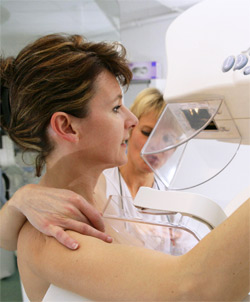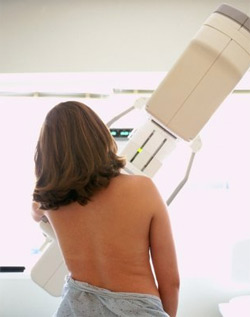
The Draft U.S. federal health guidelines have been issued which says that mammograms are a personal decision for women in their 40s. Women in their 40s should talk with their doctors and then decide for themselves whether they need regular mammograms to screen for breast cancer before age 50, according to draft U.S. federal health guidelines. The draft mammography guidelines issued April 20 by the U.S. Preventive Services Task Force (USPSTF) largely reiterate those that have been in place since 2009, the last time they were updated.
The guidelines still recommend mammograms to screen for breast cancer every two years for women ages 50 to 74. However, those recommendations are still at odds with the American Cancer Society and the American College of Obstetricians and Gynecologists. Both of those groups recommend annual screening beginning at age 40.
In the proposed USPSTF update, the task force emphasized that women in their 40s should make a decision whether or not to receive mammograms every two years after talking about their individual risk factors with their doctors.
We want to be able to empower women with the science, so they can understand the potential benefits as well as the potential harms, and make the decision thats right for them based on their own values, preferences and personal health history, said Dr. Kirsten Bibbins-Domingo, vice chair of the task force and a professor at the University of California, San Francisco School of Medicine.
That clarification could mean that insurance companies will have to start picking up the check for screening women in their 40s, even though its not explicitly recommended, said Dr. Richard Wender, chief cancer control officer for the American Cancer Society.
The task force does not make coverage decisions, and they dont comment on coverage decisions, but I think their guideline makes it clear that women should have the option to be screened starting at 40, Wender said. They the task force are not going to make that comment, but the American Cancer Society certainly will. The U.S. Preventive Services Task Force is an independent, volunteer panel of national experts who regularly review the scientific evidence and make recommendations regarding health screening procedures and preventive medicine.
The USPSTF faced stiff criticism in 2009 when it raised the recommended age for regular mammogram screenings to 50. Women 40 to 49 were encouraged to talk with their doctor about the best time to start regular, every-other-year mammography. The task force is standing by its 2009 guideline, noting that while the evidence shows that some women in their 40s will benefit from mammography, most will not, and some will be harmed.
Bibbins-Domingo said the 2009 guideline was widely misinterpreted as being against mammograms for all women in their 40s. The new recommendation is the same grade, a C grade, recommending in favor of screening for women in their 40s, but recognizing that on balance there are benefits that outweigh the harms, but only by a smaller amount, she said. So therefore, women should be aware of both benefits and harms so they can make the decision thats right for them. Wender agreed that the age recommendations are essentially the same.
Whats different is the messaging, but I wouldnt underestimate the importance of the messaging, he said. The task force was really clear and careful to say the discussion about having a mammogram between a clinician and a woman should begin at 40. I hope and anticipate that will help clarify the misperception that the task force was against screening for women 40 to 49. The most common harm from an unnecessary mammogram is a false-positive test, indicating that there is cancer where none exists, Bibbins-Domingo said. Women who receive a false positive have to undergo additional tests and procedures, and also must endure some anxiety until cancer is ruled out.
The most serious harm, however, can occur if a mammogram reveals a type of breast cancer that would not have threatened a womans health during her lifetime, she added.
Women who are overdiagnosed have to undergo surgery and cancer therapy that significantly diminish their quality of life while adding no extra years to their life span. Wender agreed that the evidence shows that mammography becomes more beneficial as a woman ages.
 Starting at around 35, the risk of breast cancer goes up year by year until youre basically around 60, he said. So at some point after 40, the benefit of screening starts to become substantially greater than the downsides associated with screening. The benefits of mammography also increase with age. Regular screening can prevent about four breast cancer deaths per 10,000 women in their 40s, but eight per 10,000 for women in their 50s and 21 per 10,000 for women in their 60s, according to the task force report.
Starting at around 35, the risk of breast cancer goes up year by year until youre basically around 60, he said. So at some point after 40, the benefit of screening starts to become substantially greater than the downsides associated with screening. The benefits of mammography also increase with age. Regular screening can prevent about four breast cancer deaths per 10,000 women in their 40s, but eight per 10,000 for women in their 50s and 21 per 10,000 for women in their 60s, according to the task force report.
In the report, the task force also showed that the harms associated with mammography steadily decrease with age. For example, there more than 1,200 false positives for every 10,000 women who undergo mammography in their 40s; by their 50s, the false positive rate declines to over 900 per 10,000 women, and even further down to just over 800 per 10,000 in their 60s.
The American Cancer Society is currently re-evaluating its mammography recommendations as part of its regular review of the current scientific evidence, Wender said. Were updating our guideline and it will be out later this year, and were looking at that pivot point again with the latest data, he said. In its updated guidelines, the USPSTF also said it was unable to make a recommendation for or against the value of 3-D mammography screening, because there is not enough evidence to show whether it will save more lives and improve womens health.
The task force also couldnt say, based on the evidence available, whether additional screening tools like ultrasound or MRI could help women with dense breasts screen for cancer.
Dense breasts are difficult to screen with standard mammography, and women with dense breasts are at increased risk of breast cancer, Bibbins-Domingo said. The task force called for more research in both areas. The public has until May 18 to comment on the draft guidelines, Bibbins-Domingo said.